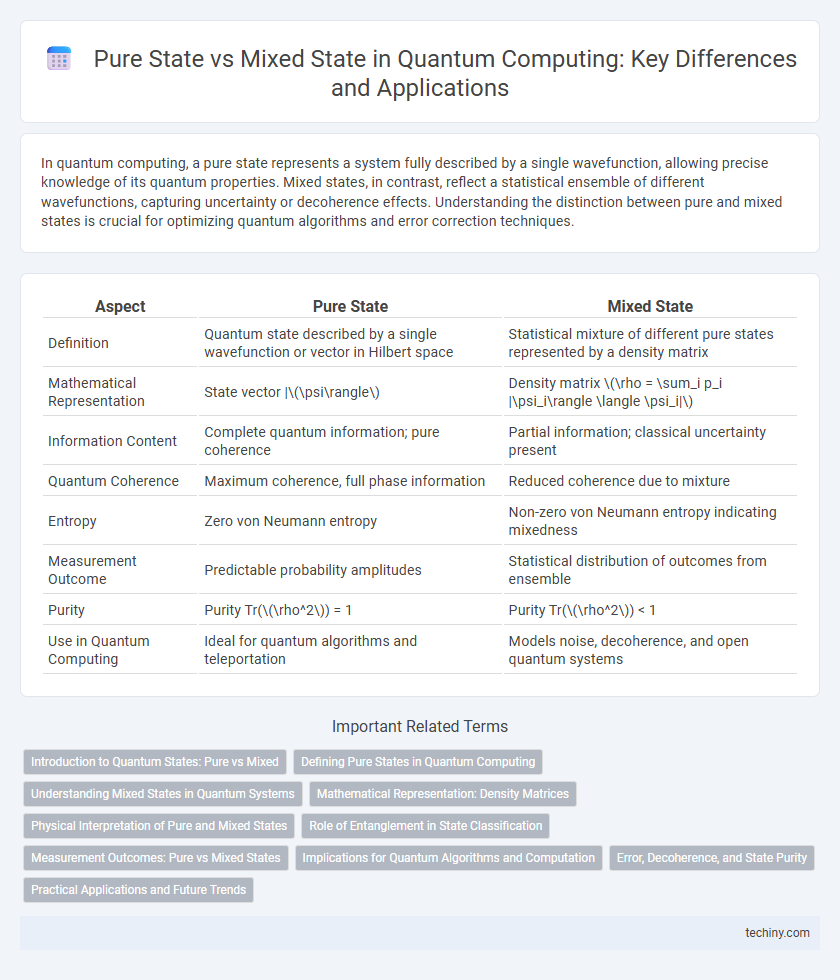In quantum computing, a pure state represents a system fully described by a single wavefunction, allowing precise knowledge of its quantum properties. Mixed states, in contrast, reflect a statistical ensemble of different wavefunctions, capturing uncertainty or decoherence effects. Understanding the distinction between pure and mixed states is crucial for optimizing quantum algorithms and error correction techniques.
Table of Comparison
| Aspect | Pure State | Mixed State |
|---|---|---|
| Definition | Quantum state described by a single wavefunction or vector in Hilbert space | Statistical mixture of different pure states represented by a density matrix |
| Mathematical Representation | State vector |\(\psi\rangle\) | Density matrix \(\rho = \sum_i p_i |\psi_i\rangle \langle \psi_i|\) |
| Information Content | Complete quantum information; pure coherence | Partial information; classical uncertainty present |
| Quantum Coherence | Maximum coherence, full phase information | Reduced coherence due to mixture |
| Entropy | Zero von Neumann entropy | Non-zero von Neumann entropy indicating mixedness |
| Measurement Outcome | Predictable probability amplitudes | Statistical distribution of outcomes from ensemble |
| Purity | Purity Tr(\(\rho^2\)) = 1 | Purity Tr(\(\rho^2\)) < 1 |
| Use in Quantum Computing | Ideal for quantum algorithms and teleportation | Models noise, decoherence, and open quantum systems |
Introduction to Quantum States: Pure vs Mixed
Quantum states describe the condition of a quantum system, with pure states represented by a single wavefunction providing complete information about the system. Mixed states are statistical mixtures of different pure states, described by a density matrix that accounts for probabilistic uncertainty and decoherence. Understanding the distinction between pure and mixed states is fundamental for quantum information processing and error correction in quantum computing.
Defining Pure States in Quantum Computing
Pure states in quantum computing represent quantum systems with complete and precise information, characterized by a single wavefunction or state vector in a Hilbert space. These states exhibit maximum coherence and can be described by the density matrix \(\rho = |\psi\rangle \langle \psi|\), where \(|\psi\rangle\) is the state vector. Unlike mixed states, which are probabilistic ensembles of pure states, pure states allow for exact predictions of measurement outcomes and underpin quantum algorithms' power.
Understanding Mixed States in Quantum Systems
Mixed states in quantum systems represent statistical ensembles of pure states, described by a density matrix rather than a single wavefunction. Unlike pure states with complete information characterized by a single ket vector, mixed states embody quantum uncertainty and decoherence effects, crucial for modeling real-world quantum systems. Understanding mixed states enables accurate analysis of quantum noise, entanglement measures, and the behavior of open quantum systems.
Mathematical Representation: Density Matrices
Pure states in quantum computing are represented by density matrices that are rank-1 projectors, expressed as r = |ps> Pure states represent quantum systems with maximum knowledge, described by a single wavefunction, reflecting complete coherence and deterministic evolution. Mixed states model statistical ensembles of different pure states, capturing uncertainty or partial information through density matrices and representing decoherence effects in physical systems. The physical interpretation highlights pure states as idealized, fully known quantum conditions, while mixed states correspond to real-world scenarios involving noise, measurements, or interactions with the environment. Entanglement serves as a fundamental criterion for distinguishing pure states from mixed states in quantum computing, where pure states exhibit maximal coherence and entanglement properties that enable quantum parallelism. In contrast, mixed states represent statistical ensembles of pure states lacking full entanglement, leading to decoherence and loss of quantum information. Quantifying entanglement through measures such as concurrence or entanglement entropy is crucial for classifying state purity and optimizing quantum algorithms. In quantum computing, pure states yield deterministic measurement outcomes with probabilities defined by the state's wavefunction, allowing precise predictions for each measurement. Mixed states represent statistical ensembles of pure states, resulting in probabilistic measurement outcomes that reflect classical uncertainty alongside quantum probabilities. Understanding the distinction helps optimize quantum algorithms and error correction by accurately characterizing system behavior during measurement. Pure states represent quantum systems with complete information described by a single wavefunction, enabling precise manipulation and interference crucial for quantum algorithms like Shor's or Grover's. Mixed states, characterized by statistical mixtures of pure states due to decoherence or noise, limit quantum coherence and reduce algorithmic efficiency by introducing uncertainty. Understanding the distinction impacts error correction protocols and the design of fault-tolerant quantum computation architectures essential for scalable quantum processors. Pure states exhibit maximum state purity and are highly sensitive to errors caused by decoherence, leading to rapid loss of quantum information. Mixed states, representing statistical mixtures of pure states, show reduced purity but demonstrate increased robustness against certain decoherence effects and environmental noise. Maintaining high fidelity in quantum computations requires minimizing errors through error correction protocols that preserve state purity in the presence of decoherence. Pure states, represented by a single vector in Hilbert space, enable precise quantum algorithms essential for quantum cryptography and error correction, while mixed states, described by density matrices, model realistic noisy quantum systems crucial for quantum machine learning and quantum communication under decoherence. Practical applications leverage pure states for high-fidelity quantum computing tasks, whereas mixed states facilitate error-resilient protocols and hybrid quantum-classical algorithms. Future trends emphasize improving coherence times and error mitigation techniques to optimize the use of pure and mixed states in scalable quantum processors and fault-tolerant quantum networks.Physical Interpretation of Pure and Mixed States
Role of Entanglement in State Classification
Measurement Outcomes: Pure vs Mixed States
Implications for Quantum Algorithms and Computation
Error, Decoherence, and State Purity
Practical Applications and Future Trends
pure state vs mixed state Infographic

 techiny.com
techiny.com